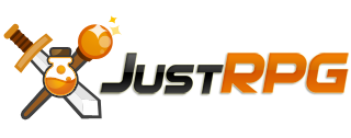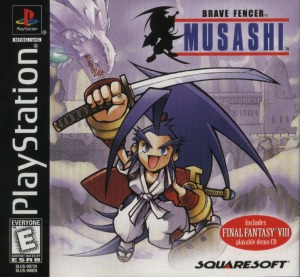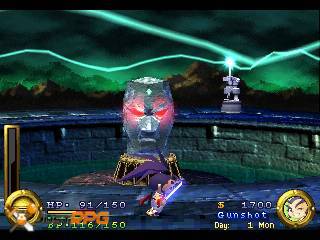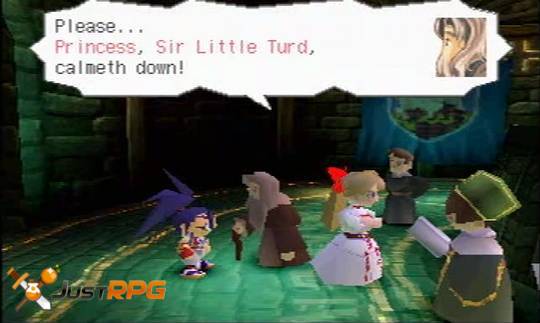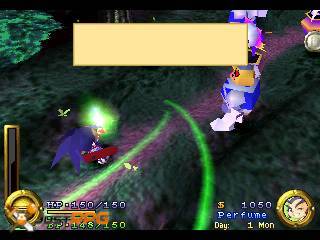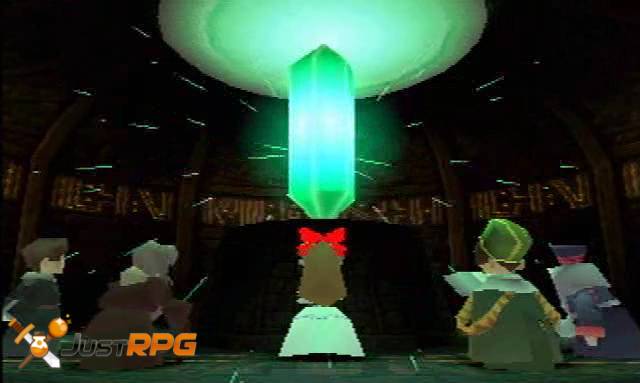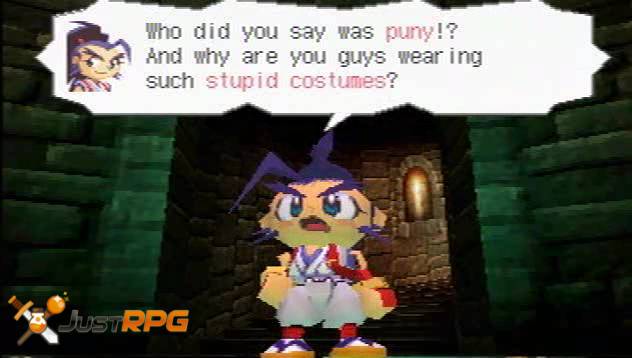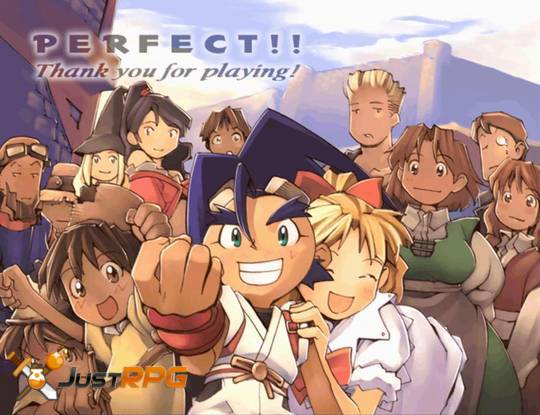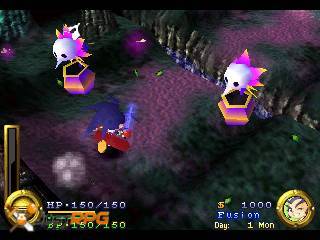In Brave Fencer Musashi players take control of a boy named Musashi who has inherited the names and swords of a legendary blademaster. He sets out to find out more about the swords, and accidentally finds himself in the middle of an evil plot to conquer the world.
Full Review
Brave Fencer Musashi Review
By, Tony Ames
Backdrop
.hack Part 1 Infection (Dot Hack) begins with a bang. Something disastrous happens to your character‘s real world friend, while innocently playing a 20 million-subscriber base, wildly popular online RPG game (MMORPG), The World. To unravel the mystery of your friend’s misfortune, you become an online, ingame rogue hacker, exploring every corner of The World, even some virus-infected ones.
The hero is armed with the special skills of Data Drain and Gate Hack, and some colorful, talented fellow adventurers to fill the two other available party slots. Different adventurers must accompany you depending on the plot‘s development. You have some control over the others in your party, including upgrading them through trades or gifts. You can play only a single class, Twin Blade. Other characters are from different classes, with varied strengths and weaknesses, from a mage type (Wavemaster) to a bully (Heavy Axeman).
Gameplay
Gameplay takes place in three principal areas – towns, fields, and dungeons. Towns house The World’s servers. There, the player can save the game, buy magic scrolls and useful and unique items, store items, buy equipment, and talk and trade with lots of other players in character online. One town has an unusual ranch to check out, a patent homage to an enduring feature of just about every Final Fantasy.
The town’s Chaos Gate provides instant teleportation to a particular wide-open Field, containing monster encounter hotspots, a mystical spring, treasure, and lots of mysterious food. You enter three distinct keywords, some known at the game‘s onset, and others learned through play. Whatever keywords are entered, the difficulty level of the destination is helpfully revealed. This prevents a low-level party from being massacred. Once the keywords are entered, you travel through the Chaos Gate. (You can enter specific keywords learned to continue the plot, do side quests, or do unlimited exploring. Or, you can instruct the Gate to enter random keywords, and take your chances. There‘s also an option to enter any keywords you wish from a word list.) Every Field houses a single Dungeon. The dungeons, where you spend much of the game fighting for your life, are not overly large in size, and always range between three and five average levels.
Many have compared Dot Hack to Phantasy Star Online Episode I and II (PSO) on the Gamecube. Let us gently discredit this. We feel Dot Hack has far better graphics than PSO. The Fields and Dungeons contain many colorful, over stylized backdrops and settings, including weather effects. Dot Hack’s monsters resemble the beautifully-drawn monsters of the later Final Fantasy’s. Dot Hack’s world is gigantic with a seeming infinite number of locations to explore. PSO’s world is relatively small, and plot is threadbare, with meaningless, though fun, side quests, which instill no enthusiasm in the player. Dot Hack’s plot is deep and complex, with each subplot advancing the story just a little bit further. (Remember though, the end of this game in no way comes close to wrapping up the story, to be completed in the three games to be released later this year.) One visual treat, however, was lifted directly from PSO – the cascading rings that accompany the teleportation of characters to and from different areas.
Combat
Dot Hack’s combat engine can best be described as modified real-time. Much like the action-RPG, Kingdom Hearts, button mashing can be effective to beat monsters. Monster combat icons appear as large yellow twirling landmarks. As you approach, the landmark dissolves, monsters come at you big-time, and, undoubtedly, players will feel a healthy adrenaline rush. Some of Dot Hack’s many monsters do not stand around waiting to be pummeled, rather some you need to catch. Dot Hack lets you turn combat almost into a turn-based affair. The player needs only to hit Triangle in the middle of battle to pause the game instantly. From there the player can give orders to the others in the party, anything from healing someone, reviving another, casting a spell, designating a target monster. Without jeopardizing your party from the hailstorm of monster blows, combat becomes a calmer, more strategic, experience. This will help the many action-challenged. Camera angles play a big role in successful combat. You must be facing a monster to do any damage. As in many games, manipulating opposing environmental elements, like fire vs. water, is a key to successful monster combat.
Dot Hack’s cyberspace setting provides a wealth of Wow-inducing outbursts. The Data Drain option in combat is a great example. When a monster’s approaches zero, the player can Data Drain to reduce a horrendous, gigantic steel robot, for example, into a sniveling, puny monster, easily defeated with a single blow. Data Drain always results in a nifty, rare item or essential Virus Cores so you can Gate Hack areas of The World now closed, but needing investigation. One bad side effect – if you defeat, a Data Drained monster, but a single experience point is earned. One REALLY bad side effect – if you Data Drain too often without giving the skill a rest, you may overload and explode. Game Over. In the case of Boss monsters, Data Drain works the same, but what remains is no sniveling puny monster, but a full-blooded slightly less tough monster. All of this makes for interesting and captivating combat, a large part of the game.
Fresh Features
Dot Hack is replete with new and interesting features that kept us riveted.
To start, the entire background and story of a real world gamer becoming a rascal hacker, penetrating deep into a virus-infected online game, is quite novel. Combine this with Dot Hack’s emulating the look and feel of an online game universe. (Message traffic on the web shows many gamers mistakenly believe Dot Hack is a real online MMORPG, along with monthly fees! No real Internet connection is required.)
Just like in the real word, Dot Hack replicates your excitement level when “New” appears before a popular forum or on your email screen. Some of the game involves receiving emails as the plot develops, as well as new, crucial information surfacing on The World’s Board. (Look out for emails challenging you to a strange game of Tag.) The online game world looks very familiar with a bunch of characters wandering around the game’s towns, with the ubiquitous balloon icons talking typical “trash” to each other, even criticizing “newbies“.
Combat grippingly called for surprisingly strategic decision-making to succeed, not related to the usual attack or defend choices. Do you go for experience and upgrade your character or try for some special equipment or a Virus Core, vital to Gate Hacking? The innovative control of other party members became second nature to us after some practice. The game rewards a player taking chances, like entering a Field or Dungeon rated 5 levels above the player’s current level. On the other hand, the game scoffed at players entering areas much lower rated the their current level, by awarding negligible experience points for victory.
Dot Hack takes progress reports to a new level, by slowly unlocking books that contain much in the way of statistics and information. There’s even a monster compendium with tips for defeating them.
Some might complain about the minimal “Save Game” ability, but we thrived on it. You explore a very hostile cyberspace environment without the facility to save. Only in a server-hosting town is saving possible at the local Recorder. We may be a solitary voice in the Wilderness, but we like this throwback to the good old RPG days. Those of you old enough to remember the Wizardry series, may recall those fingernail-biting multi-combat treks back to the Castle just to save the game. In case you’re really stuck deep in a dungeon, a common item will teleport you to the outdoor field, from where you can simply gate back to town from the command menu.
Many pieces of equipment come with distinctive powerful attack, healing, and status skills, essential to combat dominance. The player must tradeoff whether to equip something that will raise defense or offense or something less vigorous that lets you use a powerful skill. Trading is the most successful way to upgrade equipment.
In a first, Dot Hack comes with a 45 minute anime video. This gives some great background on what’s going on in The World, as well as provide clues for completing the game. In a nice twist, voiceovers for game speech can be set for Japanese or English presentation. Listening to the authentic Japanese voices really keeps you glued to the game.
Though some may scoff at what follows as meaningless, we liked the game’s unlocking of some nifty new “toys” to like, some only available when the game is cleared. You can unlock many different background music play lists. Tired of creepy tunes, just switch to something more upbeat, or futuristic. Just like real world gamers, who constantly change their desktop wallpaper, new and different wallpapers are unlocked along the way. Some are concept art of characters, while others are full blown anime renditions of the characters. This makes for great fun, and seems to pump additional energy into the game. As you progress over a dozen special cut scenes or movies will become viewable after defeating the game.
Though Dot Hack’s extras and new wrinkles enhance the RPG game experience, much of the gameplay will ring true to those who enjoy RPG‘s. Expect plenty of exploration in a huge 3D world, frequent monster combat, tons of treasure to earn and discover, upgrading your character’s weapons and armor, and needing to level before tackling pivotal story dungeons. The status screens for the characters and all equipment are well laid out and easy to grasp.
Time for Completion
Game length in hours always concerns many purchasers. A short RPG normally takes a lot of flack, and many online are asking about Dot Hack‘s time for completion. (Some have questioned whether Bandai should have released a single 80 hour game for $50, rather than four 20-hour games for $200 for a single story. This matter is beyond the scope of this review, but our high opinion of this game as a standalone is obvious.) Our experience, playing the plot without doing side quests or extra exploration, is in the 12 to 15-hour range. Players side-questing and extensively exploring, aside from the main plot, can expect to spend 25 hours to complete the game. You can even continue to advance your character, after game completion, to get a jump start on Part 2 due in May. In the next game, your character can be imported from Part 1.
Furthermore, imagine trying to explore every nook and cranny of the fields and dungeons accessible by a large number of 3-word combinations. Doing that would put the game in the 50-hour range, if not more. However, at a certain point, new items dry up, and a single experience point is earned for any defeated monster, no matter how tough.
Shortcomings
While, as is evident above, there is much to recommend in Dot Hack, certain concerns to varying degrees deserve mention.
From the “Why oh why did they leave this out?“ File. Pregame game board traffic and information about the Japanese version released months ago had many salivating for replaying the game in “parody” mode. This mode apparently converted all Dot Hack’s game world characters into satirical comedians. Sorry to say, this highly-anticipated feature is missing from the version released here.
The game requires massive amounts of button pressing. Every item or treasure uncovered from combat victories or exploration (opening chests, searching expired adventure remains, collecting food for Grunty’s, as examples) must be confirmed with a button press. When there could be 50-100 such occurrences in a single dungeon or field, over the course of the game, finger cramps seem inevitable. Baldur’s Gate: Dark Alliance also required lots of bashing for buried treasure and chests, but the items literally flew into your inventory, a much better way to handle this.
The manual is woefully terse and lacking in some crucial information and guidance. While the ingame tutorials fill in many of the gaps, one extremely important gameplay feature is missing from both the manual and tutorials – instructions on control your characters directly during combat.
Final Word
We got a kick out of Dot Hack. The feeling of “just one more dungeon” dominated our lives for the 3 days to completion. The engaging environment held our attention without much effort. The strategic nature of combat, plus the convoluted plot kept us going for hours on end. The constant unlocking of both frivolous and important gameplay features created a “what’s next” anticipation. Now, if I could only read Japanese better, Dot Hack Part 2 is already out in Japan!
Final Grade: B
Brave Fencer is almost certainly the most irritating game I’ve ever played. However, considering the amount of inarticulate rage I directed at the screen as I played, the game left me with a fairly good impression.
The irritations set in as soon as you can see the game unfold. The game is just primitive graphically. Now, this wouldn’t normally be a big concern for me personally, but in this case, it bugged me. Why? Because the poor graphics interfered with the game. All the characters and, more importantly, enemies are badly pixilated. Meaning just this: I couldn’t tell what was going on. Although I did get used to it after awhile, I’m sure I fell off more than one cliff because of it.
How irritating one finds the sound is entirely a matter of taste. This does not apply so much to the music, which is decent but with no particularly memorable tracks, but the voice acting. The voices, I think, are of reasonable quality, but some may not think so. Here’s the trick; the Voices are purposely terrible. Yes, the princess is whiny and nasal, Musashi sounds like a cocky ten-year-old, and his ‘rival’ sounds like a badly dubbed kung fu movie. However, I stick to my belief (especially since every character is similarly bad) that this is all intentional, and all the funnier for it.
The gameplay is, overall, a fun, quick-paced Zelda-clone. Musashi runs and jumps about, wielding the huge and slow Lumina and the quicker, weaker Fusion. He can also charge attacks, which has different effects. Lumina begins with a simple spin, but as you progress through the game’s 6 chapters, it acquires abilities from the Legendary Scrolls Musashi is collecting. These serve primarily as puzzle fodder. Using Fusion’s charge attack, Musashi can absorb enemies’ attacks, which are evenly split between puzzle and combat function. Musashi gains strength and ability through many means. You occasionally find Legendary Armor, which again is primarily for puzzles and exploration, which give Musashi various abilities. Oddly, none of them increase his defense. Musashi has six main stats: HP, BP (energy for absorbed attacks), Body (strength), Mind (defense), Fus (Fusion’s attack power), and Lum (Lumina’s attack power). HP is gained by eating Longevity Berries, obtained through sidequests. BP is gained by freeing prisoners (another quest), and automatically after major boss battles. Body levels based on kills, Mind on steps, and Fus and Lum by using the respective swords.
So far so good. However, Musashi also faces a large amount of jumping puzzles, some nigh-impossible enemies, and the most counter intuitive puzzles I’ve ever encountered. Example: whilst searching a mine for an underground lake, I find a large gap, with the path visibly continuing ahead and a large fan at the bottom of the screen. I test to make sure the fan can lift Musashi, then float across when the fan is blowing. However, I soon come upon a room with only one other exit, which shortly deposits me at the mine’s entrance. A couple hours later, I give up and seek help. As it turns out, the path lies beneath the fan. Yes, under the fan. And this is just the puzzle that stuck in my mind… there are others equally baffling to the sane person. Compounding this is the game’s lackluster controls. Normally, I pay little attention to how the controller moves my digital persona about, but in this case it needs mentioning. As I said above, Musashi contains quite a few jumping puzzles, which I dislike in and of themselves. However, it’s worse because the ‘Jump’ command is unresponsive at times. Also, Musashi ALWAYS runs, and therefore has to skid to a stop. Or, equally often, try to stop and fall straight off a cliff.
A quick note, though, the game picks up a lot in the final chapter, the major bosses are a good challenge (though they follow the ‘observe attacks, use newest ability, smash weakness’ pattern), and the final boss, though a tad cheap, actually looks pretty cool.
The story line is pretty cheesy as an RPG, but as a Zelda-clone isn’t unbearable. The kingdom of Allucaneet (pronounced All-you-can-eat) has been invaded by the Thirstquencher Empire while the King and Queen are on vacation. In desperation, the Princess uses the royal family secret, the Hero Summon, to find help. They get a 10 year old named Musashi, who shares his name with a legendary warrior who sealed up an evil wizard with Lumina. Told he can’t go home until he saves the Kingdom, Musashi fetches Lumina, but returns to find the Princess being kidnapped. Thinking Lumina alone may not be enough, Musashi decides to find the Legendary Scrolls to power up Lumina while he figures out how to get the princess back. Although a few twist are thrown in during the last chapter (fairly predictable ones, mind you), that’s pretty much the whole game.
What you think of characters again comes down to taste. Again, by RPG standards the characters are clichéd and never develop. However, they are a rather eccentric crew, and basically serve to keep the game funny in between your hacking of beasties. Put it this way: where else (except, perhaps, the Street Fighter movie) could you find such classic one-liners as “Vhat? I don’t vemember killing YOUR parents!”
Finally, the game is pretty short. My final time was 14 hours, with perhaps half of the sidequests and max levels. The game prompted me for a save after the credits, so there is a replay option, but no added endings or challenge, meaning it’s for completists only. All said, the nasty, evil puzzles gave me a terrible impression while struggling through the games mid-section, but the last chapter and the game’s humor saved it from a dismal grade.
Final Verdict: 74%
